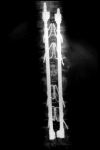Surgical treatment of solitary plasmocytoma of the spine: case series
- PMID: 15296213
- PMCID: PMC1888412
Surgical treatment of solitary plasmocytoma of the spine: case series
Abstract
The mean survival of patients with skeletal solitary plasmocytoma is 75% at 5-year follow-up. This highly osteolytic tumor may compromise spinal stability. Radiotherapy is effective in local control of the disease, however, it is not effective in restoring spinal stability. Fracture risk and progressive vertebral collapse persist. For this reason, we must consider the need to establish the probability of progressive vertebral collapse, based on the degree of involvement of the vertebral body at the time of diagnosis. We used parameters described by Taneishi and Kaneda, as well as those of Heller and Boden to predict progressive vertebral collapse. Three cases are presented and their treatment is described.
Figures











References
-
- Galieni P, Cavo M, Avvisati G, Pulsoni A, Falbo R, Bonelli MA, Russo D, Petrucci MT, Bucalossi MA. Turas: Solitary Plasmocytoma of Bone and Extramedullary Plasmocytoma: Two different Entities? Ann Oncol. 1995;6(7):687–691. - PubMed
-
- Delauche-Cavallier MC, Laredo JD, Wibier M, Bard M, Mazabraudt A, Le Bail, Darne JL, Kuntz D, Ryckewaert A. Solitary Plasmocytoma of the Spine: Long-Term Clinical Course. Cancer. 1988;61:1707–1714. - PubMed
-
- Frassica DA, Frassica FJ, Schray MF, Sim FH, Kyle RA. Solitary Plasmocytoma of Bone: Mayo Clinic Experience. Int J Radiat Oncol Biol Phys. 1989;16(1):43–48. - PubMed
-
- Taneichi H, Kaneda K, Takeda N, Abumi K, Satoh S. Risk Factors and Probability of Vertebral Body Collapse in Metastases of the Thoracic and Lumbar Spine. Spine. 1997;22:239–245. - PubMed
-
- McLain RF, Weinstein JN. Solitary Plasmocytomas of the Spine: A Review of 84 Cases. J Spinal Disord. 1989;2(2):69–74. - PubMed
Publication types
MeSH terms
LinkOut - more resources
Full Text Sources
